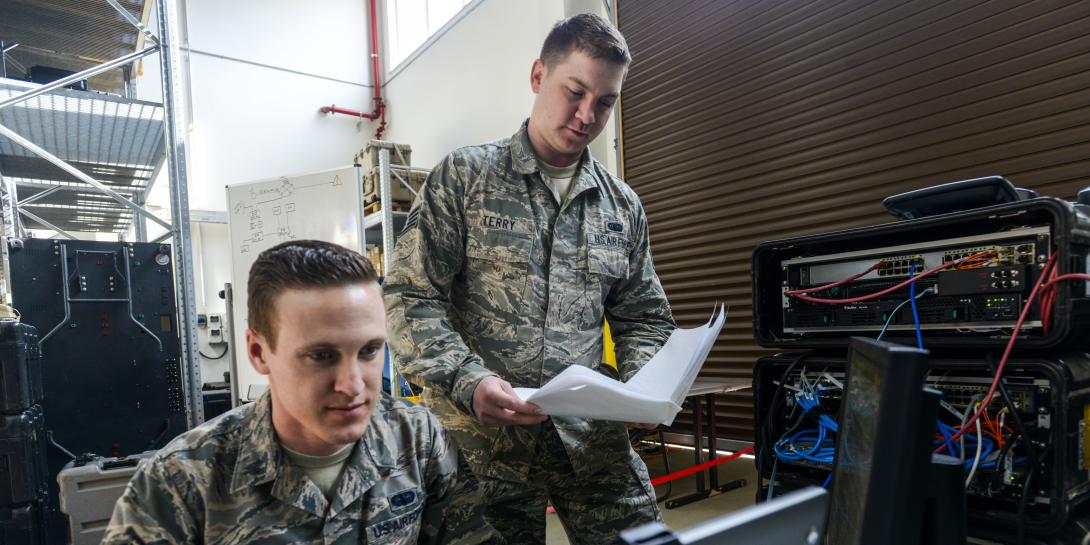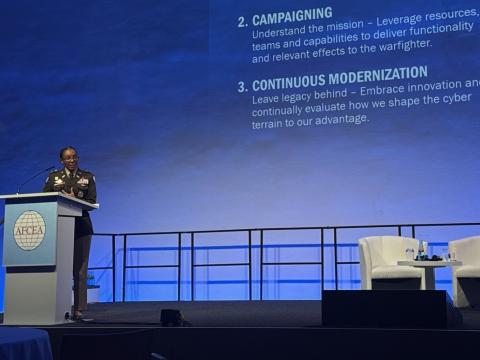The U.S. Air Force Must Aim Higher in Cyberspace
Airpower in future crises must stress cyber warfare. But some experts fear cyber effects could resemble nuclear effects, and deterrence approaches are neither the same nor effective.
Warfare, as with technology, is changing quickly and dramatically. The U.S. Defense Department’s most recent Quadrennial Defense Review noted the link between this rapid evolution and “increasingly contested battlespace in the air, sea and space domains—as well as cyberspace—in which our forces enjoyed dominance in our most recent conflicts.”
These assertions have major implications for airpower in future contingencies that will call for the Air Force to emphasize cyber over its five core missions. Already, these missions have been tweaked in content and application—changes that leaders could use to set a course for future cyber dominance.
But getting there will not be easy. Cyberspace seems limitless, given the man-made malleability of the terrain. The stakes are highest in part because the entry barriers are lowest—courtesy of readily available technologies that are being improvised to cause significant harm. The low barriers to entry result in the cyber domain presumably receiving the most focus in both contingent and local operations. These comparisons of vast highs and lows are described by the American Foreign Policy Council’s Eric Sterner in his scholarly article “Retaliatory Deterrence in Cyberspace.”
Airpower in future crises must stress cyber warfare. But some experts fear that cyber effects could resemble nuclear effects, and deterrence approaches are neither the same nor effective. More answers are needed.
Meanwhile, the United States must work to remain the global leader in science and technology to achieve joint force dominance in cyberspace, as the Quadrennial Defense Review envisions. Steps are being taken to attain that holistic dominance by identifying ways to combat full-spectrum cyber capabilities. That full spectrum includes people, hardware, software, networks, technologies and irregular activities.
Furthermore, cyberspace is a global domain in an information environment with interdependent networks that give way to a terrain unlike those of traditional ground, sea, air and space operations. Cyberspace knows no geographical boundaries. Cyber warriors require innovative approaches to how to fight, how to posture forces and how to use technological and other strengths to their advantage in this complex space. Certainly, there is no shortage of options in this unique environment.
But there is a serious shortage of cybersecurity talent. This spells trouble, given that the shift to cyber within the Air Force will require meeting consistently high demand for skilled cyber professionals. The dynamic man-made domain needs highly trained people who are passionate about their work. It is widely presumed that the Air Force will maintain the lead in cyber warfare, especially in contingencies. As a result, the Air Force will shoulder the burden of maintaining a cyber force, from recruitment to retention to retirement. Fortunately, the Defense Department is investing in cyber capabilities, including recruiting, training and retaining cyber personnel, especially the department’s newly hatched Cyber Mission Force.
The Air Force, and all the services, must leverage private industry personnel and expertise to offset talent gaps compounded by a shortage of career and education opportunities for some Defense Department cyber workers. While the value of these cyber-savvy individuals and their wealth of experiences is second to none, finding and wooing other sources of talent will be paramount to developing the cybersecurity work force necessary to meet the military’s needs.
Jennifer A. Miller is a cost analyst and a deputy branch chief in the Resource Management Oversight Division of the National Guard Bureau’s Joint Staff. She is a member of AFCEA’s Northern Virginia Chapter. The views expressed are her own.





Comments